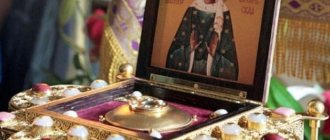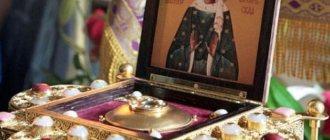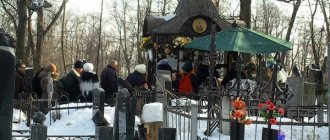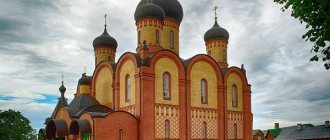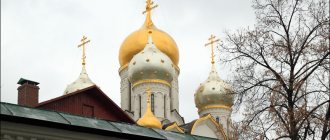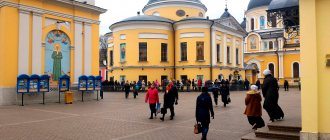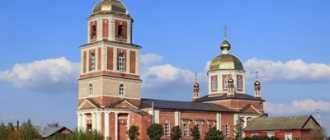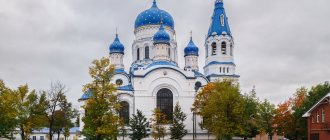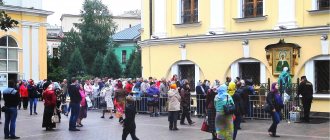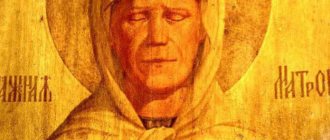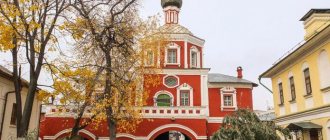The Church of the Holy Righteous Blessed Elder Matrona of Moscow is a place of pilgrimage for Orthodox people from all over the country. Since 1998, the relics of St. Matrona have been kept here. Believers go to venerate the miraculous icon and relics, bring flowers and ask Matrona for help.
An endless stream of pilgrims eager to receive Matronushka’s support arose during her lifetime at the beginning of the last century, and has not dried up since then. Tens and hundreds of people visit this holy place every day.
The Intercession Convent, in which the temple is located, was founded as a men's monastery in 1635, closed in the 1920s and reopened in 1994 as a women's monastery.
© Aleks Akishin
Icon and relics of the Blessed Matrona of Moscow
The icon of the Matrona of Moscow is located directly on the wall of the Church of the Intercession of the Blessed Virgin Mary from the street side; there is always a large line of pilgrims to see it.
The relics of the holy blessed old woman have been constantly housed in the monastery since 1998 and are stored in a special sarcophagus - a shrine. Believers note that the shrine has a beneficial effect on this place - here you immediately feel peace and tranquility, your soul becomes light and joyful. Matronushka helped many to resolve their sorrows, quench their sadness, and recover from illnesses.
© Aleks Akishin
History and architecture of the Intercession Monastery
On the territory of the monastery there is a single-domed Cathedral of the Intercession of the Blessed Virgin Mary, also known as the Church of the Matrona of Moscow on Taganka, as well as the five-domed Church of the Resurrection of the Word and a three-tier bell tower. The temples are surrounded by the vast Tagansky Park; there is a holy spring on the territory.
The monastery has a church shop where icons of St. Matrona are sold in a variety of formats - from small pocket ones to large church formats; you can also buy church utensils, oil, candles, books and much more.
The height of the bell tower of the Intercession Monastery is 30 meters
In old times, on the site of the monastery there was a cemetery where homeless people, vagabonds and wanderers were buried. In the 17th century, Tsar Mikhail Fedorovich ordered the founding of a monastery here, and at first it was called that - the monastery on Poor Houses.
The stone one-domed Cathedral of the Intercession of the Blessed Virgin Mary was built in 1655, rebuilt in 1806–1814, the Church of the Resurrection of the Word was built in the 18th century.
During the Patriotic War of 1812, the monastery was occupied by a general of Napoleon's army, and it was almost completely destroyed. The monastery was damaged for the second time in the 1920s. The times of the New Economic Policy turned out to be the most disastrous for him - the bell tower was blown up, various offices and entertainment establishments were opened in the former monastic monasteries and classrooms of the theological seminary. In the post-war years, the monastery fell into complete desolation, and only in the mid-1990s was it revived and again transferred to the Russian Orthodox Church.
© Dmitry Mozzhukhin
Church shop
On the territory of the Intercession Monastery there is a church shop, which offers a variety of goods for performing rituals, visiting temples and reading prayers at home. You can buy rare church literature and candles there. The oil brought from the monastery has healing powers. Parishioners are happy to buy flowers in the church shop, but only after venerating the relics of the holy Elder Matrona. It is believed that these flowers will protect the house from troubles and misfortunes for a long time. Just don’t need to throw them away after they wither. The petals should be picked and dried.
In the shop you can buy church fabrics, baptismal shirts, pectoral crosses and accessories. Wedding rings purchased at the monastery will protect young spouses and preserve their marriage. On the territory of the Intercession Convent, you can also purchase many colorful souvenirs for personal use or for gifts.
To support the Intercession Stauropegic Convent, you can not only buy something in the shop, but also make a voluntary donation during a personal visit or remotely by sending any amount to the official bank account of a religious organization.
Holy Blessed Matrona of Moscow
Matrona of Moscow is one of the most revered Orthodox saints. During her lifetime, she became famous as a great benefactor. There were always pilgrims in her house, whom Elder Matrona helped, instructed, healed, and prayed for. Even during her lifetime, she was revered by the monks of the Trinity-Sergius Lavra.
Matrona was born in the Tula province, the fourth child in a poor peasant family, with elderly parents. She was born blind, with underdeveloped eyeballs. At first, Natalya Nikitichna and Dmitry Ivanovich Nikonov wanted to abandon the blind girl and give her to an orphanage in the neighboring village of Buchalki. But one day the mother had a prophetic dream: a beautiful white bird flew to her chest, and the woman saw that the bird was blind. Then she realized that her daughter needed to be left in the family.
From early childhood, Matrona discovered deep faith in the Lord and the ability to heal and predict the future. At a young age, her legs were paralyzed, but this did not stop Saint Matrona from traveling and making pilgrimages to holy places.
Life says that Elder Matrona was able to predict her own death in three days, and until the last day she did not stop hosting the suffering. Her grave was also a popular place of pilgrimage for several decades, until the relics were transferred to the Intercession Monastery on Taganka. Matrona of Moscow was canonized in 2004.
And today, dozens of people come every day to the Temple of the Matrona of Moscow in the Intercession Monastery, bringing fresh flowers, most often white roses and chrysanthemums, which Matrona loved most, and Matronushka helps all those who suffer. According to believers, the holy blessed Matrona helps in a variety of troubles and sorrows: serious illnesses, loss of loved ones, infertility.
Order requirements on the official website
© Anatoly Novikov
Shrines located in the monastery
The Intercession Monastery houses two of the most significant shrines:
- relics of Matrona of Moscow;
- Icon of the Mother of God “Seeking the Lost.”
There are many legends about the icon kept within the walls of the monastery. It was painted by an unknown icon painter, but he received a blessing to begin work from the Elder Matrona herself. After some time, the artist complained that he could not continue his work and that an unknown force was preventing him. Matrona advised him to confess and take communion. The icon painter listened to the advice and was able to finish the work.
Schedule of services
The Intercession Convent is open to visitors every day from 7.00 am to 20.00 pm, on Sundays - from 6.00 am to 20.00 pm.
On weekdays the flow of pilgrims is smaller; on weekends you will have to stand in line for several hours to touch the icon and relics of Matrona. Families with small children will always be greeted with a smile, let ahead, and offered a cradle for babies.
Daily:
- morning service - at 7.30,
- evening - at 16.00 or 16:45.
On Sundays:
- at 6:15 - early Liturgy,
- at 9:00 - late Liturgy,
- at 16:45 - evening service.
On the dates of important Orthodox holidays, all-night vigils, daily vigils, or polyeleos are served.
Detailed schedule of services on the website of the Intercession Monastery
Rules of conduct on the territory of the monastery
When visiting the Intercession Monastery, it is important to follow a number of rules. The following is prohibited on the territory:
- conduct video and photography;
- talk noisily, laugh;
- smoke and drink alcohol.
It is worth paying attention to the appearance. Visitors should wear long skirts or dresses, but not trousers or provocative clothing. There must be a scarf or any other suitable headdress on your head. It is better to avoid wearing bright makeup before visiting the monastery.
It is better to turn off your mobile phone when entering the monastery gates. Calls will not distract from prayers and contemplation of beauty, enjoying silence. You cannot take animals with you.
Temple of the Matrona of Moscow on Taganka: how to get there
The address of the Pokrovsky Stavropegial Convent is Moscow, st. Taganskaya, 58, Tagansky district.
How to get to the Matrona Temple on Taganka by metro
The easiest way to get there is by metro along the Kalininskaya line (yellow line) to the Marksistskaya station, exit towards the street. Taganskaya, from there take any trolleybus or tram to the Bolshaya Andronevskaya stop.
You can take the metro along the Tagansko-Krasnopresnenskaya line (purple line) or the Circle line (brown) to Taganskaya station, from there go to Marksistskaya and exit to Taganskaya street.
Or take the metro along the Lyublinsko-Dmitrovskaya line (light green line) to the Krestyanskaya Zastava station or on the Tagansko-Krasnopresnenskaya line (purple line) to the Proletarskaya station, from there walk five minutes to Abelmanovskaya Zastava Square.
Kazan Church
Travel by public transport: from Moscow from Vykhino station by bus to Bronnitsy, from Bronnitsy by bus to Ramenskoye to the stop. Boyarkino, then walk 5 km. Another travel option: from Moscow from Kazansky station by train to Ramenskoye, from there by bus to Bronnitsy to the stop. Boyarkino, then walk 5 km. Or by train from the Kazansky station to the Fabrichnaya platform, from there by bus 25 or minibus 25 directly to the temple.
Travel by car: From Moscow along the Ryazan highway to Bronnitsy; then in Bronnitsy turn left onto the fifty-kilometer ring (A-107); along this road across the bridge over the Moscow River until the turn to Boyarkino; through Boyarkino to Markovo - 6 km.
The Kazan Church in the village of Markovo was built in 1672-1680. in the estate of Prince Yakov Nikitich Odoevsky, a prominent and influential boyar who controlled the Streletsky Prikaz and the Grand Kazan Palace. Therefore, it is not surprising that the interior decoration of the temple was made by masters of the Royal Armory.
Based on the architecture of the church and historical data, it can be assumed that its author was Pavel Potekhin, a serf architect of the Odoevsky family (and later the Cherkassky family). Among the temples he built, there are temples in Arkhangelskoye and Nikolo-Uryupin that are very similar in composition and architectural design.
The Church of the Kazan Icon of the Mother of God is built of brick, on a basement, with one dome on the main volume and with four chapels. Both the central part and the side chapels originally had “fiery” endings from tiers of kokoshniks; in the 19th century, the kokoshniks were cut off and replaced with an inexpressive hipped roof. In the 1990-2000s. During the restoration, the original appearance of the building was restored. The ceiling of the central part of the temple is also curious - it rests on walls and two round pillars and consists of a complex system of arches, vaults and half-vaults. The aisles are not located completely symmetrically: the two western ones are adjacent to the corners, the two eastern ones are adjacent to the walls of the main volume. According to their design, they copy the central part of the temple. The building is surrounded by a covered porch along the perimeter on three sides.
The external decor of the temple was very rich, in the style of Russian patterning: the architect used tiles, carved stone and patterned brick. The windows are decorated with lush platbands, the corners are framed with tiled inserts, and there is a frieze under the rows of kokoshniks. The light central drum is also decorated with tiles.
In the 19th century, the western porch was dismantled and a rather simple bell tower was added. The parish of the village, remote from the main roads, was very poor, and the church could barely be kept in decent shape. During Soviet times, the church was badly damaged - only the lower tiers of the temple itself and the bell tower remained. In the early 1990s. it was handed over to the community of believers, and later the courtyard of the Moscow Pokrovsky women's stauropegial monastery was located here at the Intercession Gate . An Orthodox shelter for girls was also established there. From that moment on, the church began to be restored much faster, and now on the banks of the Moscow River stands a red-brick church surrounded by a new fence and completely renovated.
Included in the projects:
Pavel Potekhin
